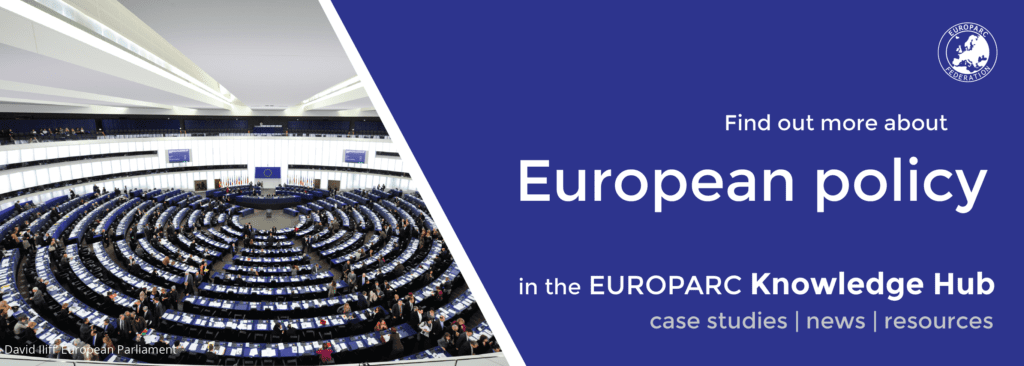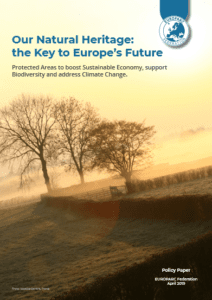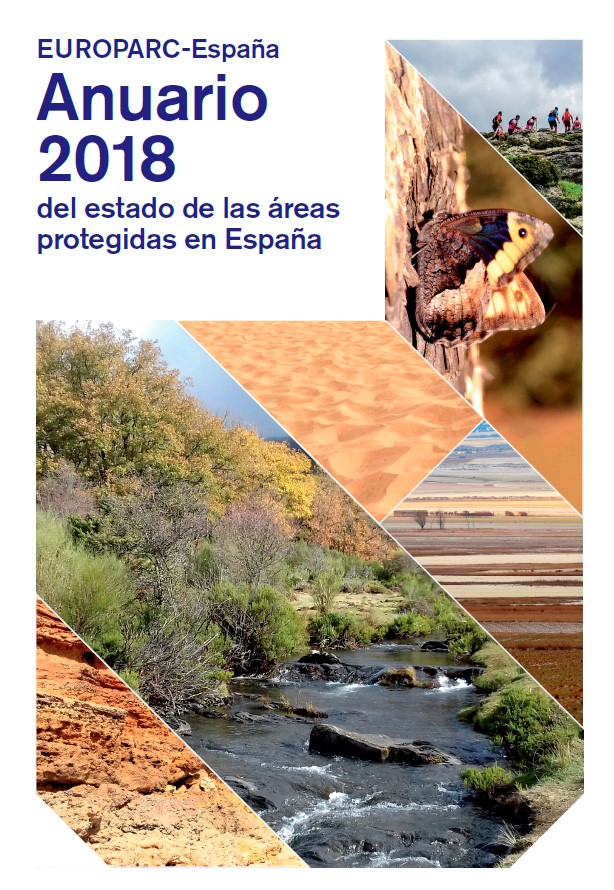EU Elections & Climate change: a call for Action in Brussels
article issued by Enzo Lavarra, EUROPARC Council Member and former Member of the European Parliament
Scientists from all over the world have been warning global political global decision-makers for decades about the risks of a general collapse of the “Earth system” due to climatic changes. That must constitute a fundamental compass towards a new paradigm of sustainable development.
The climate is now widely present in public perception and our common consciousness. The driving force behind this awareness is now revealing itself to be great and unprecedented: the global movement of “Greta Thunberg’s” generation, starting with the extraordinary initiative of the “Fridays for Future“.
The system of European parks and their most representative association, EUROPARC Federation, brings to this new perspective the baggage of its own experience and actions.
Around the key principle of nature and ecosystem protection, parks are implementing initiatives based on rigorous principles of ecological sustainability, on quality agriculture connected with the local culture and traditions, on intelligent tourism and not environmentally aggressive, on the enhancement and attention to the landscape, on the relationship, typically European, between environment, cultures and territories.
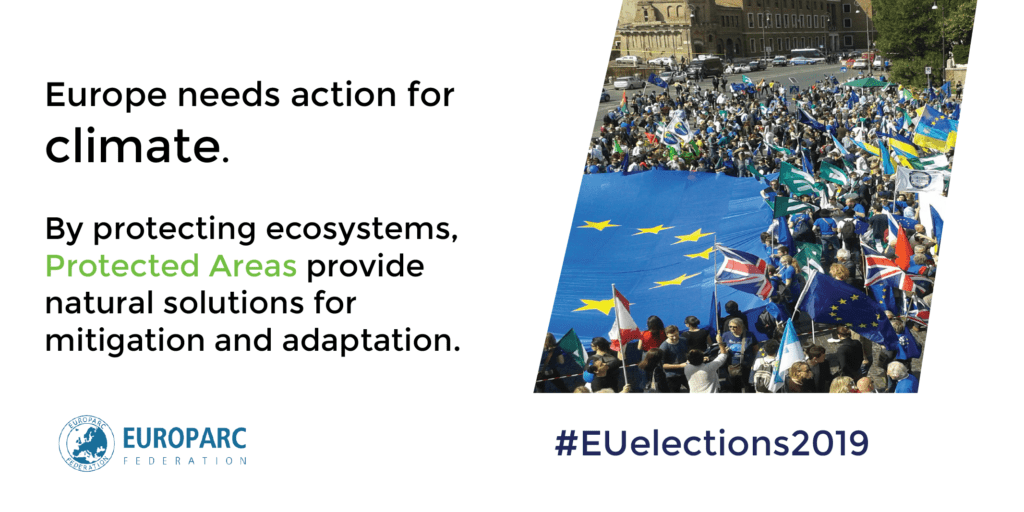
How are Parks contributing?
In mountain areas, parks promote policies dealing with melting glaciers and shrinking permafrost. In marine areas, they act on the protection of species, sustainable fishing and fight against invasion of plastic. Periurban and urban parks work to reinforce green belts and to create green and ecological cities. And for the rivers, parks are committed to improve water quality and make watercourses as real “life chains”.
Most of these initiatives are supported through European funds linked to EU programs and nature directives. And recently, the European Parliament has approved a report on cohesion policies which recognizes the role of protected natural areas in the fight against climate change.
For these reasons, the system of European parks associated with the EUROPARC Federation, calls to action all elected MEPs and their political representatives, in order to
consider climate change and sustainable development as a priority of the legislative action of the new Parliament, of the Commission, of the European Council.
EUROPARC Federation is committed to dialogue and to offer its contribution in order to:
1) Consolidate the “parks system” as promoters of a new way of thinking and on acting against climate change
2) Propose transnational, national and regional parks as stakeholders representing widespread interests, and as interlocutors for political decisions on sustainable development, quality of territories and landscape, social cohesion
3) Enhance protected areas’ contribution to ecosystem conservation. Ecosystems, as expressed also by the European Commission, produce positive values e.g. in supplying water and timber, in the regulation of water cycle, in cultural services (nature and landscape);
4) Recognize networks on Climate change that EUROPARC and its members intend to build with Universities, Foundations, Environmental associations, public and private bodies.
In this context, the Parks system, through its representation expressed in EUROPARC, intends to play a significant role as an educational, informative and communicational vehicle to obtain positive effects on the awareness of the problem and of the very tight timescale for acting. Parks can act both as amplifiers of the global alarm, as sources of correct information, and as forerunners of climate change adaption and mitigation.
EUROPARC’s Call to Action
WHAT WE ASK: Put Climate Policies high on the priority list, ensuring the integration of Nature Conservation in general, and valuing the role of Protected Areas in particular, in the EU Climate strategies and targets.
WHY? Europe needs action for climate. Protected Areas are key element to tackling climate change by protecting ecosystems, which provide natural solutions for mitigation and adaption. Ecosystems perform important services for society, such as climate regulation, carbon sequestration and storage, flood protection, water purification, water provision and soil erosion prevention.
To safeguard these fundamental services, resilient ecosystems are needed to cope with the impacts of climate change. To address climate challenges faced by European landscapes and biodiversity, EUROPARC is promoting habitats conservation and restoration, ensuring better resilience of ecosystems, and is raising capacity among managers to improve adaptation measures and planning in protected areas.
These and other measures at EUROPARC-EU-Natural-Heritage-Policy-Paper (also available in Italian and French)
The state of Protected Areas in Spain – Yearbook 2018 by EUROPARC Spain
To celebrate the World Environment Day, EUROPARC Spain launched the 2018 Yearbook of the state of Protected Areas in Spain. Following EUROPARC’s Spain commitment of “having a living observatory of protected areas in the Spanish State”, in 1999 they implemented a systematic methodology to collect annually information on the:
- Protected terrestrial and marine area coverage
- Current status of planning of protected natural areas and the Network Natura 2000
- Evolution of the economic and human resources dedicated to the management of protected areas,
- Management effectiveness
- Examples of new governance models
- Evolution of visits to national and natural parks
- Contribution to the welfare of the society of these territories.
- Perspectives on connectivity and adaptation to climate change
The Yearbook comes out just one year before the balance of the 20 Aichi Targets assumed a decade ago by the Convention on Biological Diversity, that aimed to halt biodiversity loss on the planet, ensure the sustainable use of natural resources and equitably distribute the benefits of conservation. The review shows that Spain will partially fulfill some of the commitments in terms of quantitative targets, specifically those set out in Target 11.

In Spain, over 27% of the protected terrestrial area and about 13% of marine protected waters are included in the Natura 2000 network,
making Spain with one of the European countries with the largest Natura 2000 coverage. In quantitative terms and on a global scale, there is a positive evolution. Currently, 238,563 protected areas are covered covering 20 million km2, equivalent to 14.9% of the land area. With regard to marine protection, it would have reached 7%, mainly in the exclusive economic zone (up to 200 nautical miles, with 16.8% and only 1.2% beyond 200 nautical miles from the coast).
However, Target 11 also poses complex challenges. In addition to designating places with the implications of previous studies, social-political commitment, they must be managed effectively and equitably. And needs to be connected and integrated into the territory. Evaluating these aspects requires necessarily deepen the analysis of the means (legal, material, economic and human resources) and procedures governing the management of such sites.
From numbers… to management effectiveness
Significant progress has also been made in the management of protected areas, but, nevertheless, despite the overcoming of the most difficult years of the economic crisis, the average investment in the parks continues to fall, which does not comply with the increase in the number of visitors.
Investment in protected areas and its efficient management are strategic in an ecological transition horizon, the fight against climate change and education and enjoyment of the values of nature. With an average investment in parks continuing to decrease € 54 / ha in national parks (the lowest registered) and € 26 / ha in natural parks (values similar to 2010), EUROPARC Spain, claims that budgetary allocations of protected areas need to be improved, so that they can adequately meet their very important functions.
For the promotion and strengthening of protected areas as preferential territories for the conservation of nature and sustainable development, in harmony with the United Nations Sustainable Development Goals (ODS).
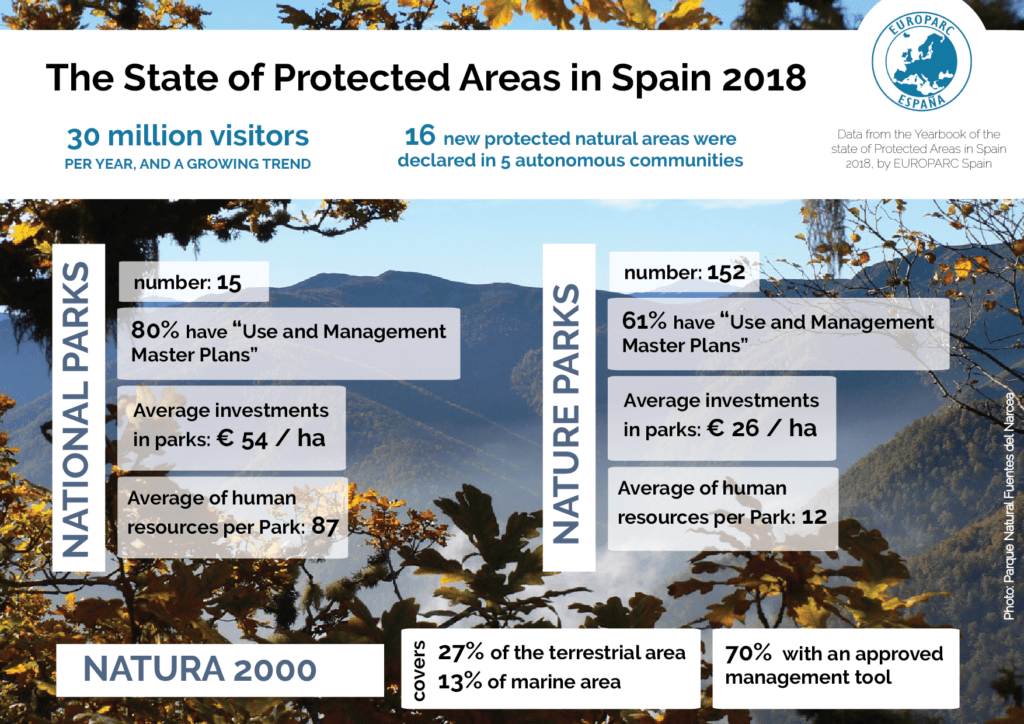
The state of Spanish protected areas in a nutshell:
1) The 27% of the protected land area has been exceeded, included in the Natura 2000 Network, and almost 13% of the marine surface has been protected. Spain has complied with the international commitment to declare at least 17% of land and 10% of the marine surface.
2) There are 15 national parks and 152 natural parks declared in Spain. There are also 291 nature reserves, 342 natural monuments, 57 protected landscapes, and more than 800 spaces, usually of small size, designated with other figures developed by the autonomous communities.
3) Between 2017 and 2018, 16 new protected natural areas have been declared in five autonomous communities. Furthermore, the large marine protected area of the Mediterranean Cetacean Migration Corridor has been also declared.
4) Among the new areas protected by international schemes, the Ponga Biosphere Reserve has been declared: Spain is the country that hosts the highest number Biosphere Reserves, with a total number of 49. Additionally, a new RAMSAR site, a new Geopark and a new UNESCO natural site have been declared.
5) Significant progress has been made in planning: 80% of national parks and 61% of natural parks have PRUGs (Use and Management Master Plans). 70% of the Natura 2000 spaces have an approved management tool.
6) Average investments in parks continue a decreasing trend: € 54 / ha in national parks (the lowest registered) and € 26 / ha in natural parks (values similar to 2010).
7) The human resources dedicated to the management of the parks follow a similar pattern since 2012: an average of 87 people in national parks and 12 in natural parks.
8) The estimated number of visitors in national and natural parks exceeds 30 million, with an increasing trend in national parks.
9) 43% of the agreements of land stewardship, a tool for involving society in conservation, have been implemented totally or partially in spaces adhered to the Network Natura 2000, covering a surface of more than 265,000 hectares.
10) The State Strategy for green infrastructure, connectivity and ecological restoration has been released to the public and it is still in the process of formal approval. Additionally, several autonomous communities have approved strategic documents.
